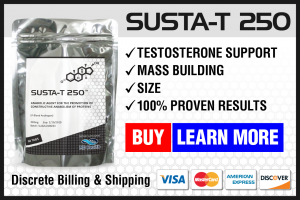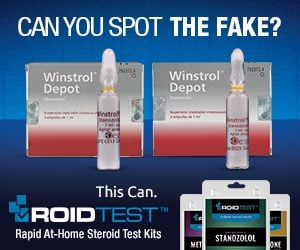Testosterone is perhaps the safest anabolic steroid where side effects are concerned from the standpoint that it is the naturally produced anabolic steroid by the human body. Logic follows that by utilizing a hormone that the human body already produces and is already accustomed to is a far safer and more reliable practice than using a modified form of Testosterone (which is what essentially all other anabolic steroid analogues are). Although these modified Testosterone analogues for the most part operate almost identically to Testosterone in the human body, these modifications essentially create a whole new compound that is essentially foreign to the human body. Thus this is why some individuals may react worse to another particular anabolic steroid, but may react just fine to Testosterone. It must be clarified, however, that the different esterified Testosterone variants in the Sustanon 250 blend are not modified analogues of Testosterone itself – the Testosterone chemical structure remains unchanged once the body’s enzymes remove the ester attached to it. The esters that are bound to the Testosterone structure serve only to augment the release rates and half-life of Testosterone, not the actual effects and properties of Testosterone itself.
Testosterone is not without its potential side effects, however, and it does possess the potential for various undesirable side effects which will be covered here. As Sustanon 250 is a Testosterone preparation, Sustanon 250 side effects would be the exact same side effects associated with Testosterone in general.
Estrogenic Side Effects
Sustanon 250 being a blend of Testosterone esters suffers from aromatization into Estrogen in the body. Thus Sustanon 250 side effects also include that of Estrogenic side effects. The rate at which Testosterone aromatizes into Estrogen is in direct relation with the dose used. In increasing doses, Testosterone has a higher rate for aromatization, and so it stands to reason that bodybuilding doses can and do elicit moderate aromatase activity. Estrogen can cause the following side effects: water retention and bloating, blood pressure elevations (as a result of the water retention), increased possible fat retention/gain, and gynecomastia. Higher and higher doses of Sustanon 250 will require the use of an aromatase inhibitor, which serves to disable the aromatase enzyme, which is responsible for converting Testosterone into Estrogen – this effectively halts Estrogen production at its root. The use of an AI, as a result, would effectively control and put a stop to nearly all Estrogen-related side effects. The other possible option is the use of a SERM (Selective Estrogen Receptor Modulator) such as Nolvadex, which serves to block Estrogen from attaching to receptor sites in breast tissue. SERMs such as Nolvadex will only serve to remedy the issue of gynecomastia caused by Estrogen, and will not actually reduce serum Estrogen levels in the body – an aromatase inhibitor is what is required for this.
Androgenic Side Effects
Sustanon 250 side effects do include androgenic side effects as well, as Testosterone is the body’s primary male androgen and possesses moderate androgenic activity on its own (androgenic rating of 100). However, the more severe and stronger androgenic side effects as a result of Testosterone are actually the result of Testosterone being reduced (or, converted) into the far stronger androgen known as Dihydrotestosterone (DHT) by way of the 5-alpha reductase enzyme. The 5-alpha reductase enzyme is present in large amounts in certain tissues, such as the scalp, prostate, and the skin. When Testosterone reaches these tissues, it undergoes a high rate of reduction into its more potent androgenic metabolite DHT. It is this conversion into DHT that is responsible for the majority of androgenic side effects. In order to prevent this conversion, ancillary drugs such as Proscar and Dutasteride can be used, which serve to disable serum levels of the 5-alpha reductase enzyme, thereby stopping DHT conversion at its roots – although it is important to note that this will not completely eliminate androgenic side effects, as Testosterone itself possesses androgenic effects as well. An additional therapy would be the topical use of the shampoo Nizoral on the scalp, where its active ingredient Ketoconazole effectively blocks DHT from binding to receptors on the scalp (or wherever it is rubbed on) much like the relation between a SERM and Estrogen in breast tissue. This will effectively reduce the chances of male pattern baldness (MPB) and/or acne breakouts. Androgenic side effects as a whole include: increased sebum secretion (oily skin), increased bouts of acne (linked to increased sebum secretion), bodily and facial hair growth, and the increased risk of triggering Male Pattern Baldness (MPB) in individuals that possess the genetic trait required for the condition to manifest itself.
HPTA and Endogenous Testosterone Production Side Effects
All anabolic steroids possess the capability to suppress and/or shut down the body’s natural endogenous Testosterone production, and Sustanon 250 side effects are no exception to this fact. The administration of exogenous Testosterone from Sustanon 250 will inevitably suppress and at the worst case shut down natural endogenous production for the duration of the cycle. Upon termination of the cycle, it is highly advised that the user engage in a proper PCT (Post Cycle Therapy) protocol, which includes the use of Testosterone production stimulating ancillary compounds, such as Nolvadex and/or HCG (Human Chorionic Gonadotropin) for a typical PCT period of 4 – 6 weeks following the end of a cycle. Failure to do so can result in permanent damage to the HPTA (Hypothalamic Pituitary Testicular Axis) whereby the individual will insufficiently produce proper levels of Testosterone for life, ultimately requiring medical intervention in the form of TRT (Testosterone Replacement Therapy).
Hepatotoxic Side Effects
Sustanon 250 side effects do not include that of hepatotoxicity (liver toxicity). Testosterone possesses no structural modifications (such as C17-alpha alkylation in oral anabolic steroids) that would cause hepatotoxicity. Studies have investigated the potential for hepatotoxicity with Testosterone used at high doses (400mg daily, which equates to 2,800mg weekly) in several male test subjects for a 20 day period where the route of administration was actually oral instead of intramuscular injections. The idea here was to saturate the liver with high amounts of Testosterone (all orally ingested substances make what is known as a ‘first pass’ through the liver and interact with the liver at a far greater rate than the injectable route of administration). The result of the study was that no changes were observed[1].
Cardiovascular Side Effects
Cardiovascular strain and negative cholesterol changes belong to the list of Sustanon 250 side effects, and this is also a side effect common among all anabolic steroids, and especially oral anabolic steroids. This involves the reduction of HDL (the good cholesterol) and increases of LDL (the bad cholesterol). The result of such changes involves an increased risk of arteriosclerosis, and the degree to which these changes occur for the worse are usually dose-dependent (with higher doses increasing the negative changes and the risks). Other factors that affect these negative cholesterol changes are: duration of use, and route of administration. Testosterone itself actually happens to exhibit far less of an impact on cholesterol values in this case than all other anabolic steroids, as one of the contributing factors in this case is due to the liver’s ability to freely metabolize Testosterone, and the fact that Testosterone is not extremely resistant to hepatic breakdown and metabolism. The issue where hepatotoxicity is concerned mostly stems from certain anabolic steroids that possess the trait of exhibiting heavier resistance to hepatic metabolism than Testosterone is. This is one of the main reasons as to why oral anabolic steroids exhibit varying levels of hepatotoxicity – the C17-alpha alkylation causes the anabolic steroid to become further resistant to being metabolized or broken down by the liver. The concern as to whether an anabolic steroid has a high resistance to hepatic metabolism or a low resistance is a factor in how much impact a given anabolic steroid has on the liver’s management of cholesterol .
Testosterone in particular has demonstrated in one clinical study to have only a mild impact on HDL cholesterol after a 12 week period where 280mg of Testosterone Enanthate was administered weekly. The cholesterol profiles had later changed for the worse when an aromatase inhibitor was included, which resulted in a significant 25% drop in HDL cholesterol[2]. Conversely, other studies have been conducted whereby 300mg weekly of Testosterone Enanthate was administered for a 20 week period without the use of an aromatase inhibitor which resulted in a 13% reduction of HDL cholesterol, however, when Testosterone doses were raised to 600mg weekly, reduction of HDL cholesterol had dropped to 21%[3]. From the data examined, it is very evident that the increase in Estrogen via aromatization and liver metabolism actually helps to offset the negative cholesterol changes from the use of supraphysiological amounts of anabolic steroids. This makes sense, considering Estrogen itself is known to promote positive impacts on cholesterol levels. Therefore, the use of an aromatase inhibitor and its impact on cholesterol profiles should always be remembered when any user is considering the addition of an aromatase inhibitor on cycle. It is advisable to instead use minimal doses of an aromatase inhibitor while on a cycle for the purpose of Estrogen control rather than total Estrogen level elimination. The idea in such a case is to keep Estrogen levels within normal ranges and not allow them to skyrocket as a result of aromatization, but at the same time prevent them from dropping to near zero from the use of full doses of an aromatase inhibitor.
Sustanon 250 References:
[1] Enzyme induction by oral testosterone. Johnsen SG, Kampmann JP, Bennet EP, Jorgensen F. 1976 Clin Pharmacol Ther 20:233-237






